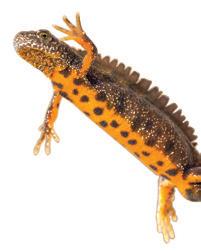
6 minute read
TIME TUNNEL
from Wild Magazine Autumn 2021
by essexwt
We travel back to... 2001
...to give you a glimpse of our past and see what was happening at the Trust.
One year after the millennium, Essex Wildlife Trust’s Autumn 2001 magazine focused on a watery world. Lin Wenlock, who at the time was the Chairman of the Trust’s Conservation Committee, unlocked some of the secrets of the wildlife within a garden pond.
What was happening globally in 2001:
• Harry Potter and the Philosopher’s Stone was the highest grossing film. • Italy’s Leaning Tower of Pisa reopened after 11 years spent fortifying the 12th-century tower. • Wikipedia, a free Wiki content encyclopaedia, goes online. • September 11 saw aircraft crash into the
World Trade Centre & The Pentagon. • The first draft of the complete human genome was published in Nature. • The World population reached 6.2 billion while the population of Britain was 58.8 million.
Wildlife in ponds
Water is the source of life, and it is not until you have a garden pond that you realise what a wildlife oasis it provides.
At the bottom of the pond animal life feeds on a steady flow of dead and waste material from above. Animals with fascinating names such as the bloodworm, the rat-tailed maggot, and the sludgeworm share in this vital cleaning role.
On the surface of the pond, pond skaters and whirligig beetles, aptly named by the way they move, feed on small flies that fall into the water. Below the surface the great diving beetle has to swim vigorously to stay near the bottom, the air stored beneath its wing cases making it extremely buoyant. It is a bold hunter, often hanging on to water plants with the second pair of legs, leaving the first pair free to catch its prey.
Above the surface from the end of May to the end of August the dragonflies are on the wing. They are large, heavily built and powerful predators capable of very fast flight and feed on insects, which they catch and often consume while still in flight. In spring, the mating pair crawl to the water to lay their eggs which hatch into predatory nymphs living among the water weed. The nymph will lie in wait for prey, capturing it with a swift movement of its hinged, strongly clawed mask. After two years the nymph crawls out of the water on to an emergent plant for the final moult. The larval skin splits down the back enabling the fully developed insect to haul itself free.
Big or small, ponds for all. Ponds were the focus of Wild About Gardens 2020. Read The Wildlife Trust’s guidance on garden ponds and learn how to create your own at www.wildaboutgardens.org.uk. Migrating from nearby larger ponds, and looking like a miniature aquatic dragon, the great crested newt can be seen lurking in the warm, weedy shallows. Easily the largest of the three species of British newts, the great crested newt can grow to 16 centimetres long. On top its warty skin is very dark, often black, speckled with tiny white spots. Its belly is usually orange to yellow with irregular black spots.
Spending most of the year on land where their skins are dry to touch, the adults must, towards the end of the winter, return to the water to breed. They become adapted to living in water, their skins get thinner and their tails narrower. Males develop a high wavy crest along their backs and another along their tails, which have a broad, iridescent stripe along each side.
Eggs are laid singly on underwater leaves near the water margin. Leaves are folded over and sealed to protect them from predators. Four weeks later the eggs hatch and tadpoles emerge, looking like tiny transparent fish.
Three months after hatching the young newt is ready to leave the water. For the next two to three years newly emerged great crested newts stay away from their birth ponds, returning after this time to breed. In October or November as temperatures start to fall, they hibernate, usually on land, choosing sheltered, damp, frost-free nooks, sometimes underground. They re-emerge in the spring to start the cycle of events again.
The whole point of a wildlife pond is to attract wildlife to your garden, and many species are only present in the pond for a short time, or on a seasonal basis. As the seasons change so do the pleasures offered by a garden pond.
Cel Spellman
@celspellman
Raise your voice
I’m proud to be part of an organisation with a rich history of driving change. As a supporter of The Wildlife Trusts, I know I’m part of a community that stands up and uses its collective voice for nature. Together, we’ve achieved huge and crucial changes, from reintroducing wildlife like the beaver, to protecting our seas — a huge carbon store — with the Marine Act. All of this plays a massive part in turning the tide against nature’s loss and climate change and would not have been possible without people coming together and speaking up.
However, a question that often seems to present itself is, ‘Does protesting actually work?’. For me, the answer is simple – a resounding yes! But there are numerous ways to do this. We tend to think of protests as big rallies and marches, which is often the case and can absolutely work. I was privileged to be involved with the Time is Now march in 2019 for urgent climate change action; the hope and positivity in the air was palpable. It’s moments like these that help you feel like you’re not alone and that change can and will come.
The School Climate Strikes also provides a shining example. Young people making their voices, thoughts and feelings clear. For me, these strikes have been one of the biggest reasons we’ve seen a shift in mindset and conversation around climate over the last few years. Young people’s voices are some of the most powerful and they never cease to blow me away with how aware they are, and the absolute drive they have for making the world a better, fairer, greener place.
But marches aren’t the only way to make our voices heard. Signing petitions, sharing something we see online, having those difficult, important conversations with friends, or writing to our MP or a business can also have a huge impact. 10-year-old Skye from Gwynedd is a huge inspiration to me; she campaigned for magazines to stop giving away disposable plastic toys. In response, Waitrose said they’ll no longer sell children’s magazines containing disposable plastic toys, a move single-handedly inspired by Skye, and I’ve no doubt other businesses will follow suit. That is the power of our voice.
We can also protest with our wallets. Money talks, and by choosing where we spend ours, who we invest in, who we bank with, we can express our beliefs and support businesses or individuals that share them.
It’s about putting pressure on those that need the pressure applying. However this is done, you really can make a difference for the environment, for nature, for our wonderful wildlife and in turn, for ourselves and our future. I’ve no doubt that together we can and will change the world.
To quote Charlie Chaplin in the Great Dictator, ‘You, the people, have the power to make this life free and beautiful, to make this life a wonderful adventure…’


To tackle the climate and nature emergency we face, our natural world needs advocates on its side. Find out about the big issues at
wildlifetrusts.org/emergency SHOUT FOR WILDLIFE
Join over 100,000 people speaking up with The Wildlife Trusts on everything from better laws for wildlife to banning the sale of peat compost. Together our voices can make a difference. You can sign up to our campaigns mailing list to be the first to hear when new campaigns are launching so that you can take your stand for nature’s recovery. To register, visit
wildlifetrusts.org/ campaigns
Cel Spellman is an actor and presenter, an ambassador for The Wildlife Trusts, and an ardent advocate for nature, wildlife and the need to address the climate crisis.





